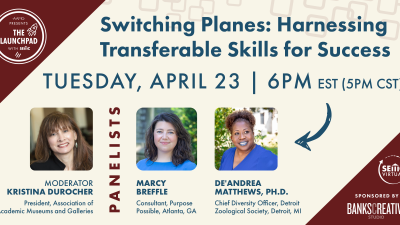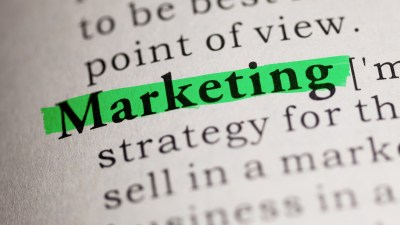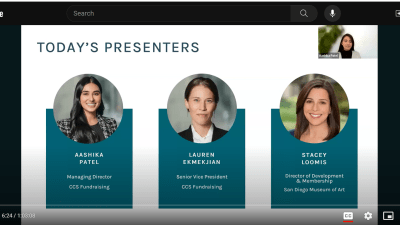
Support Free COVID-19 Resources for the Field:
The current crisis is taking a distressing financial toll on cultural organizations, and AAM is no different. The Center for the Future of Museums is supported by AAM membership and donations. In these challenging times, we ask that if you can, consider making a donation or becoming a member of AAM. Thank you for your much-needed support.
Update from Elizabeth (3-18-20): since I wrote this post last week, Spain and France announced lockdowns, President Trump recommended that people avoid gatherings of ten people or more, and Orange County, California, banned all public and private gatherings through the end of the month. Thus demonstrating how hard it is to stay ahead of the curve when trying to forecast the pace of change in the middle of a crisis. As you tailor the scenarios embedded below for your own museum, keep this in mind: you may be pretty sure about what will happen, but uncertain about when. That is ok! You are not trying to make predictions–you are prepping your organization to respond to whatever might come.
This week I feel like my futurist training is of critical importance—because foresight is all about creating plans resilient enough to succeed in times of great uncertainty. Everyone is trying to understand what COVID-19 is going to mean for their family, their community, and their organizations. Museum people are no exception. You and your colleagues may be worried and distracted. (You may, like me, be struggling not to check the awesome and yet frightening Johns Hopkins Global Coronavirus Cases Map more than two or three times a day.) When contemplating what you might do to respond to the unfolding pandemic, the number of possible actions can seem overwhelming. This post provides some guidance on using scenarios as a tool to map your way forward in the coming days and weeks. (Hopefully lowering your personal and institutional anxiety levels at the same time.) And as you plan your response, make use of this growing compilation of information and resources developed by my colleagues at the Alliance.
Sample Scenarios: Three Potential Levels of Impact
Scenarios are basically stories: imagined futures based on the intersection of trends and potentially disruptive events. By creating several stories about how things may play out, you can identify how you might adapt to changing circumstances, focus your attention on critical indicators, and identify and minimize the attendant risks. Scenarios provide a way of collapsing potential futures into a manageable number of possibilities and provide a framework for planning how you might respond.
I suggest you start by creating stories around three possible levels of impact your community may experience during this pandemic: low, medium, and high. Each scenario should briefly capture the major elements of this version of the future and provide a few thought-provoking and evocative details. Strive to be plausible, but don’t labor over making it entirely “correct”—one major purpose of the stories is to give yourself and your colleagues something to respond to.
To help you get started, here are some thoughts on these three potential levels of impact, and a super-short scenario for each that you are welcome to expand and adapt for your own planning. These examples are not meant to be perfect or complete! They are starting points for your own exploration and improvements. For examples of longer, more detailed scenarios (about the world generally, not COVID-19) and suggestions for using scenarios in planning download TrendsWatch: The Scenario Edition.
Low Impact
Every community is at some risk for the spread of COVID-19. However, in some communities this risk may be relatively low due to their circumstances: for example, relative geographic isolation, or absence of major travel hubs. (Other communities may avoid infection through sheer luck.) Even in low-impact communities, museums will face challenges associated with the pandemic, including:
- Heightened concern on the part of visitors and staff
- Reductions in international and domestic tourism
- Economic repercussions of COVID-19 to the museum directly and to its community at large.
Scenario One: Stay Calm and Carry On
This scenario explores how the (fictional) Buckthorn Art Museum helped the (fictional) township of Buckthorn, Missouri, reassure residents and practice social distancing while coping with the economic and psychological fallout of the COVID-19 pandemic.
Download the full scenario here: Covid-Scenario-One-Stay-Calm
Medium Impact
Whether or not they have reported cases of COVID-19 yet, some communities are at elevated risk. They may contain major transportation hubs (airports, train stations, etc.), host events that draw travelers (conferences, sporting events, festivals), or be home to military bases, colleges or universities, or businesses that send employees on frequent travel. However, even after cases of COVID-19 have been detected, some communities may curtail its spread via good communications, testing, early diagnosis, and quarantine.
In addition to the stresses listed in the low-impact case above, museums in medium-impact communities may have to contend with:
- Recommendations from local authorities to limit public gatherings
- Significant drops in attendance (with corresponding loss of income via admissions, sales, etc.)
- Cancellation of space rentals by clients
- Ripple effects of decisions by a large local organization, (for example, a college or university cancelling classes, asking students not to leave campus, or not to return to campus after break).
Scenario Two: Scaling Back
This scenario explores how the (fictional) Justinia History Museum played a vital role in helping its community respond to the 2020 COVID-19 pandemic, while creating strategies to compensate for the damage to its own finances.
Download the full scenario here: COVID-Scenario-Two-Scaling-Back
High Impact
As I write, there have been over 1,700 reported cases of COVID-19 in the US (you can monitor the latest numbers by country and state here.) Based on what is already playing out in affected areas, museums in cities and regions with significant outbreaks of coronavirus may have to contend with:
- Mandatory closing of public facilities
- Mandatory closing of public and private schools
- Bans on gatherings of large numbers of people
- Cancellation of conferences, festivals, and sporting events that drive local tourism
- Reduction in flights into local airports
- Reported incidents of COVID-19 among museum staff, family members of staff, or visitors. (Note that this could happen in any of these scenarios; it is just more likely in a high impact situation.)
Scenario Three: Lock Down
This scenario explores how the small (fictional) Seattle Gaming Museum navigated the COVID-19 crisis in the context of the state and city response to the unfolding pandemic. This scenario is a starting point for exploring how a museum might respond to the widespread closure of public facilities and the potential of staff exposure to COVID-19.
Download the full scenario here: COVID-Scenario-Three-Lock-Down
How can you use these scenarios to help plan your response?
I encourage you to convene a group at your museum to review these sample scenarios. (If your staff are already telecommuting, you could use a platform such as Zoom, FaceTime, or Google Hangouts to support the discussion online.) Tailor these prototypes to fit your circumstances or use them as a jumping-off point to write your own. You may want to:
- Add more details
- Question specific elements of the story that you feel are unlikely, or not applicable to your museum’s context
- Introduce elements that address challenges of particular concern to your organization
Share the scenarios you have created with staff tasked with planning your COVID-19 response. As you discuss each scenario encourage participants to:
- Say, “If this happened, then we might do that…”
- Ask, “What if…?”
- Recognize responses that are common to all scenarios, and therefore are things you can start doing now
- List actions that you should consider, assign staff to evaluate costs and develop implementation plans
- Estimate the financial risk to the museum under each scenario
How will you know which of these scenarios will be closest to true?
Good question, and one you should discuss with your team. I recommend you identify indicators that might tell you when your own circumstances are trending towards scenarios 1, 2, or 3. For example, you might monitor:
- Reported incidents of COVID-19 in your city or region
- Announcements or declarations by government officials (local, state, or federal)
- Closures or program cancellations by local organizations, including other cultural organizations, schools, and houses of worship
- Internal metrics—admissions, sales, program registrations
- Inquiries from concerned visitors
- Self-reporting by staff regarding potential exposure to COVID-19
You may want to create a calendar of key dates and decisions that need to be made, for example:
- Go/no go decisions on events
- Deadlines for cancelling contracts or reservations with the least financial penalty
- Legal obligations for the fulfillment of contracts or grants
Planning for the health and well-being of your staff
COVID-19 will have profound impacts on the museum workforce. People may need to take sick leave for treatment, quarantine, or care of family members. They or their partner may lose work hours and pay. Even those not directly affected by the crisis in terms of exposure or employment may suffer significant psychological stress. To help your organization support the health and well-being of your staff in any of these scenarios, you may want to explore the following issues and collect relevant information:
- How many of your staff receive no paid sick leave (and therefore may be reluctant to stay home if they feel ill)?
- How many of your staff are hourly employees, who would receive no compensation if they are not coming to work?
- How many of your staff self-identify as being at high risk for COVID-19, or are concerned about exposing family members who are at high risk?
- How many of your staff have school-age children, and are or may be coping with school closures?
- How can you support staff in working remotely, and what functions would still require staff on site?
Consider, for each scenario, how you can safeguard the health of your staff and provide the financial and psychological support they need during the coming months.
Financial planning
After the health, well-being, and safety of staff and visitors, the biggest concern for many museums is going to be the financial impact of COVID-19 on their organization, both in the immediate future and long-term. To lay the groundwork for exploring the financial impacts of your scenarios, you may want to collect the following information:
- What are your museum’s current cash reserves? (Funds you can access quickly to meet financial obligations.)
- What are your average weekly operating costs?
- What is your current mix of revenue (earned, contributed, government, investment)? What are the largest current sources of income?
- What recent trends in your museum’s ticket sales, registrations for events, bookings, etc., may track the emerging impact of COVID-19 on your operations?
- Do you have any large financial obligations looming?
- Does the museum have any performance obligations attached to contracts or grants? (For example, if you cancel certain events, that may affect sponsorship contracts. Or, you may have grant funding that requires deliverables on specific deadlines.)
- Are there contracts or obligations you can cancel or defer with minimal penalty?
- What insurance do you have, and what coverage does it offer for financial losses, including cancellation of events, etc.?
Consider, for each scenario, at what point would you need to begin to take significant measures to cut costs/find new sources of income in order to meet your financial obligations.
What’s Next?
The Alliance is continuing to collect, organize and share the best information we can find on COVID-19 and COVID-19 response. Monitor the AAM website and communications for updates as we add to this growing body of resources. Please contact us at content@aam-us.org if you are interested in writing a piece for the Alliance blogs on what you are doing in your institution, or to suggest resources we might add to our lists.
On March 17 we will release TrendsWatch: The Future of Financial Sustainability. This edition of CFM’s forecasting report is particularly timely, given the financial stress that the pandemic will impose on many museums. It is our hope that the commentary, analysis, and examples in this year’s edition will help museums improve their long-term bottom lines.
However, unfolding events require museums to create short-term strategies to shore up their finances as well. In coming weeks, I will work with colleagues to pull together resources and examples of how museums might respond to their immediate financial needs—please let me know if you have advice to share with our field. You can reach me at emerritt@aam-us.org.
Yours from the (hopefully healthy and virus-free) future,
Elizabeth
Skip over related stories to continue reading article








Thank you for this resource. Following the lead of other institutions and this guide, my museum has engaged more actively with its online communities via existing social media and we’re working to improve our *occassional* blog.
What this guide does, perhaps unintentionally, is highlight just how the museum industry’s part-time, hourly, contract, internship, and on-call employees have the most to lose from this current global public health crisis.
Even in the first, low-impact scenario, the health of uninsured, under-benefited workers depends upon upper level staff contributing their accrued sick leave time to a pool servicing other workers. This seemingly generous measure is suggestive of the volatile reality in which museums keep their staff.
Not all museums provide adequate paid time off to precarious staff; few offer medical coverage for them. On-call gallery technicians, student interns, distance contractors, facilities staff, and other museum personnel, who may not have the protection of guaranteed work nor benefits, are left largely unprotected during this crisis. Often employed under an “at will” legal status, these workers are the first to have their hours cut (or be laid-off altogether) as part of the museums’ financial strategy.
The low impact scenario places many precarious museum staff in financial straits. The high impact scenario is devastating.
A local outbreak forces the indefinite closure of the fictional Seattle Gaming Museum. The board treasurer is able to meet payroll obligations for about two weeks while the museum’s independently-wealthy director foregoes his own salary to allow more financial resources to support the museum’s other three staff in quarantine.
After a few weeks of closure, the museum is only able to survive because it receives a slice of Amazon’s Neighborhood Small Relief Fund. “This enabled the museum to maintain rent payments and salaries until they reopened.” But how long is that? A few weeks? A month? Three months? How long could the fictional Seattle Gaming Museum actually remain in business and meet payroll obligations with its doors shuttered, staff WFH, funded only by a small community grant? There’s the rub. Not every small institution, independent gallery, and museum without access to financial reserves will be able to weather the storm of a global public health crisis that calls for folks to shelter and avoid public spaces. For museums that may not have the protection of parent institutions and massive professional organizations nor access to conspicuous generosity from Silicon Valley, staff layoff and permanent closure is a real possibility. Yet, they have to do it.
I’m glad to see places like the Getty guaranteeing to pay its out-of-work employees in full throughout the duration of this crisis. But, in the same poll by the LA Times, 10/11 LA County museums have laid off staff without pay (https://www.latimes.com/entertainment-arts/story/2020-03-17/coronavirus-museums-part-time-hourly-employees-getting-paid).
It’s far too late for many museums to prepare for this crisis, but before the next emergency comes (whatever it may be) museums must offer health benefits including paid time off and medical coverage to all staff, including part time workers, contract workers, nonessential personnel, and interns. This is essential. ALL museum staff must be medically and financially protected. Financial reserve policies should be staff-focused, primarily concerned with meeting payroll obligations and offering resources to staff during closure.
Thank you again for this guide, I’m certain that many institutions will find it a valuable resource when planning their own COVID-19 responses. I do look forward to your upcoming blog post on financial strategies to mitigate facilities closures during this time.
Great resources and most of these scenarios were implemented in our Museum once we closed to the public on March 14. Since we are a private/public Museum and have two types of funding, we were able to take care of our staff during COVID-19. We had scenarios is all three categories. I have set up a meeting with all DC Museums to discuss for strategies for opening. This would include PPEs (especially gloves and mask) for our staff and volunteers who engage with the public, new signage for “social distancing” for the public (inside and outside) in order to control the lines which also includes our ticketing system. We are normally in high season operations at this time hosting more than 8,500 visitors a day, but our “assumption” is that we will open with Low Season in mind which is about 2,500 or 3,000 per day. We will still have to implement new safety precautions for staff, volunteers and visitors who visit the Museum. Has AAM or any other Museum’s looking at strategies for reopening once the call is made. We are working on our Decision Points now so we are ready once the call is made by WHO or the Governors of each state. Your thoughts?